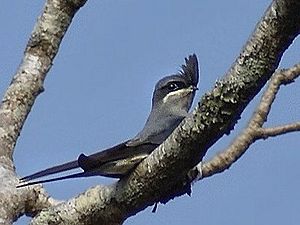Treeswift facts for kids
Quick facts for kids Treeswifts |
|
|---|---|
 |
|
| Crested treeswift (Hemiprocne coronata) | |
| Scientific classification |
|
| Kingdom: | Animalia |
| Phylum: | Chordata |
| Class: | Aves |
| Order: | Apodiformes |
| Family: | Hemiprocnidae Oberholser, 1906 |
| Genus: | Hemiprocne Nitzsch, 1829 |
| Species | |
|
See text. |
|
Treeswifts, also known as crested swifts, are a special family of birds called Hemiprocnidae. They are very similar to the true swifts you might already know. There's only one group, or genus, of treeswifts, called Hemiprocne, and it includes four different species. You can find these birds living in a wide area, from India and Southeast Asia all the way through Indonesia to New Guinea and the Solomon Islands.
Treeswifts are small to medium-sized birds, usually between 15 and 30 centimeters long. They have long wings, but their upper arms are actually quite short. Unlike other swifts, treeswifts have softer feathers. They also have cool crests or other fancy marks on their faces, and long, forked tails.
One big difference from other swifts is that treeswifts can perch on branches! True swifts can't do this. Male treeswifts often have shiny, colorful feathers on their backs.
Where Treeswifts Live
Treeswifts live in many different kinds of places. For example, the whiskered treeswift loves old, untouched forests. It's very good at flying through trees and usually stays close to the plants under the forest roof. It rarely goes into newer forests or farms, and never flies over open ground.
Other treeswift species are less picky about where they live. The crested treeswift can be found in many places, including wet forests and woodlands where trees lose their leaves. The grey-rumped treeswift lives in almost every type of habitat, from mangrove forests to hill forests. All treeswifts eat insects, but scientists haven't studied exactly what insects they prefer to eat.
Nests and Young
Both male and female treeswifts help build their nests. They lay just one egg in the nest, which they cleverly glue to an open tree branch. The eggs can be white or grey.
Scientists don't know much about how long treeswift eggs take to hatch. However, they think it takes longer for the eggs of bigger treeswift species. When the chicks hatch, they are covered in soft grey fuzz. Their parents feed them by bringing back food and spitting it up for them to eat.
Types of Treeswifts
Here are the four species of treeswifts:
- Crested treeswift, H. coronata
- Grey-rumped treeswift, H. longipennis
- Whiskered treeswift, H. comata
- Moustached treeswift, H. mystacea
Images for kids
-
Moustached treeswift on its nest in Biak, New Guinea.
See also
 In Spanish: Vencejos arborícolas para niños
In Spanish: Vencejos arborícolas para niños


